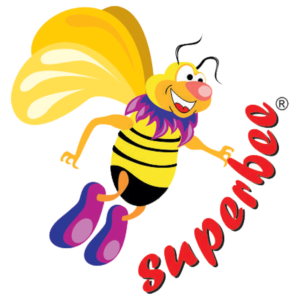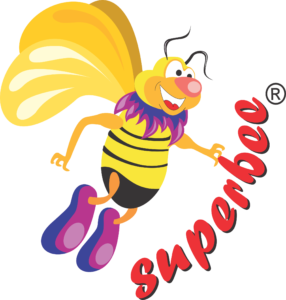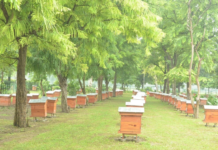Good management practices are the key to success of a beekeeper. Seasonal management of honey bee colonies involves seasonal manipulations of hive and hive space to provide room when necessary for the expanding brood-rearing area and for storage of surplus honey. Some recommendations for seasonal management are as under:
Summer Management
- Micro climate of the colony should be regulated by keeping wet gunny bags over the top cover and sprinkling water on and around the colonies in the apiary during noon hours.
- Clean and fresh water should be available near colonies. Clean water could also be fed inside the hives. (For first 2-3 days of placing fresh water feeders the may not take it, but once they start they will be benefited).
- Colonies should be kept under thick shade and along avenue of trees or bushes to avoid high temperature and westerly hot winds during summer.
- Entrance of the colony should be wide enough to maintain proper ventilation. Provide additional gate to multi chambered colonies.
- During summers number of frames should be reduced by 1
- Place extra super with empty frames, without combs or comb foundation for the bees to expand their cluster.
- To sustain fresh air flow a thin stick piece should be kept between two adjacent chambers.
Monsoon Management
- Apiary and colonies should be placed/moved to under shade with clear flow of air so that humidity does not stagnate in the apiary.
- Apiary and colonies should be kept clean. Ensure frequent change of the bottom boards with clean and dry ones.
- Thick Sugar syrup and pollen substitute should be fed as per requirements of the colony.
- Weak, diseased and laying worker colonies should be kept together in a separate yard.
- Predator’s attacks should be kept under control by using non toxic methods.
Monsoon Season & Autumn Management
This is the period when colonies should be prepared for future honey flow
- There should be enough space in the colonies for ventilation and movements of bees.
- Colonies should be strengthened to stimulate brood rearing by providing the colonies with simulative sugar feeding at night only.
- Old black combs and those infested with pests should be cleared (collected and boiled with water to separate the wax)and replaced by clean new combs.
- Ectoparasitic mites, wax moth and predatory wasps should be controlled carefully and effectively.
- As soon as the presence of fresh wax / comb building is observed the colonies should be provided with frames with fresh comb foundation to fill up the space in the brood chamber and feed the colonies with (50:50) sugar syrup for 3-4 days. Even the darker combs can be replaced with new comb foundation frames at this time. This operation will stimulate the building of new combs and increased brood rearing.

Winter Management
- Plains and Foot Hills of India
- This is the productive period in the plains and foot-hills in India.
- In late Autumn and early winter adding new comb foundation and managing the bee colonies for increased brood rearing be continue.
- As the drone brood appears steps for queen rearing and swarm control should be taken.
- In the selected colonies for queen rearing good larger sized queen cells should be selected, marked and utilized for rearing good quality queens.
- Supers, preferably half or shallow supers with drawn combs or with new comb foundation should be added to full 9 to 10 frame bee colonies.
- More supers should be ready for use as additional ones or to more colonies that are developing.
- As the supers get filled and sealed arrangements for honey extraction and handling in hygienic and contamination free way should be taken.
- Higher Hills with severe winters
- Colonies should be examined regularly.
- Colonies should be shifted to place with enough sun light.
- Winter cover should be provided to weak colonies.
- Sugar syrup or pollen substitute should be fed to weak colonies as this Stimulative feeding provides energy and helps initiating brood rearing.
- Wind breakers should be used to protect bees from chilly and frosty winds.
- Weak colonies should be united with stronger ones.
Spring Management.
- Sufficient space and cleanness should be maintained and provided.
- Stimulative sugar/pollen substitute should be provided to increase brood rearing.
- Colonies should be balanced and equalized.
- Old, contaminated and worn out hive parts should be replaced.
- Extra frames should be raised by providing comb foundation sheets.
- Colonies should be supervised to prevent swarming.
- Old queen should be replaced with new ones through mass queen rearing or divide the colonies.
- Colonies should be regularly monitored for ectoparasitic mites and adopt control measures.
- Honey should be extracted frequently during this season and handled with hygiene.
Are you looking for honeybee training courses in India?











